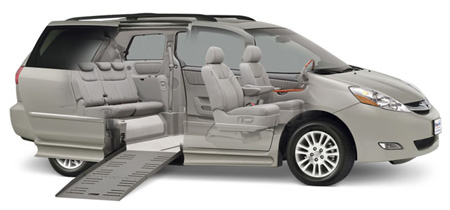If buying a car is Dante’s sixth circle of hell, well, then buying a wheelchair accessible car is the seventh. We are in the thick of the car buying process and here are a few things we’ve learned.
Depending on the type of power wheel chair and your current car, you may be able to adapt your car with a lift.
Exterior Lifts – Are lifts for the outside of the car. It seems scooters are most commonly transported in exterior lifts. Exterior lifts tend to be the most reasonably priced of all the lifts. The downside of these being that your wheelchair is exposed to the elements and other drivers. If someone rear ends you, they rear end your chair too.
Interior lifts – Are lifts that pick up the wheel chair and place the chair inside the trunk of an SUV or van. They have some pretty cool curbside lifts, like this one. The weight capacity of the lift varies depending on which one you buy. Pediatric power chairs tend to be heavier because of the additional functionality required of them. My daughter’s chair, a Permobil K450, goes all the way down to the floor. It’s an awesome chair, but it’s heavy and big. We tried to make a curbside lift work for us, but weren't able too. If you’re looking into an interior lift with an arm, you need to make sure your car has enough width AFTER the arm is added as well as ensuring the that arm can handle the weight. You need the wheelchair to fit when the chair is in it’s highest position.
Side-entry minivans - A side entry either allows the person in the wheelchair to be either in the front passenger position (assuming an adult) or in the middle of the car where the second row would be. This has multiple issues for families with small children. With a side-entry, only the wheelchair can sit in the second row because you need clearance to turn the wheelchair around inside the car. No one can sit next to the wheel chair in the second row. For us, this meant my son would be sitting alone in the third row and my daughter alone in the second. That’s clearly not ideal. The other issue with a side-entry is that you need to be in a double-wide handicapped spot to have enough clearance for the ramp (or take up two parking spots).

Rear-entry minivans – If you get a rear-entry minivan, you lose cargo space because the minivan needs a path down the middle of the car to travel. What you gain however is the ability to have the person in the wheelchair sit almost side-by-side two middle row passengers in captain’s chairs. We won’t be able to parallel park and get the wheelchair out in the same go, but that seems like a small price to pay to have our kids sit side-by-side. Numerous sales people have cautioned us against a rear-entry van saying that it would be dangerous for my daughter to back out in traffic. While I see their point, I’m not letting my three-year-old back out into rush hour, so I don’t think it will be a problem.
Ramps - Both side entry and rear entry vans come equipped with manual or automatic ramps. All modern manual ramps are now spring-loaded so they are fairly light to lift although you will be bending down to the ground. The automatic ramp works with either a button at the driver’s seat or remote.
This certainly isn’t all we’ve learned in our crash-course in wheel chair car buying. There’s plenty more to share: like how your car won’t be modified on the spot but will be shipped to one of the conversion locations across the country to a conversion center (thus incurring you shipping costs both ways).
But there is an upside to the wheelchair placard/plates – the coveted parking spot in crowded parking lots!


No comments:
Post a Comment